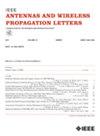用于GEO和LEO卫星通信的频率可重构单端口手持天线
IF 4.8
2区 计算机科学
Q2 ENGINEERING, ELECTRICAL & ELECTRONIC
引用次数: 0
摘要
本文介绍了一种基于可重构技术的单端口手持终端天线,用于S波段(1.98 GHz ~ 2.01 GHz、2.17 GHz ~ 2.2 GHz)地球静止轨道(GEO)卫星通信和L波段(1.518 GHz ~ 1.525 GHz、1.668 GHz ~ 1.675 GHz)低地球轨道(LEO)卫星通信。四线螺旋天线(QHA)是将两组不同螺距的螺旋天线集成在一个结构中。较低的QHA具有较小的音高,而较高的QHA具有较大的音高。这些螺旋被堆叠并缠绕在相同的介质支撑圆柱体上,形成紧凑而高效的天线结构。上下螺旋使用p-i-n二极管互连,使所提出的QHA的可重构操作成为可能。通过p-i-n二极管控制辐射臂的开/关状态,天线可以在GEO和LEO卫星通信模式之间无缝切换。创新之处在于p-i-n二极管的直流控制信号和射频信号的馈电网络共享,这有效地消除了对额外直流偏置线的需求,从而最大限度地减少了直流控制电路对天线辐射性能的影响。此外,在QHA的基础上设计并实现了基于宽边耦合带状线多层结构的小型化宽带四相功率分网,实现了两个频段的圆极化。测量结果表明,获得了良好的阻抗匹配(S11< - 15dB)和轴向比(AR < 0.5 dB)。此外,增益在L波段±80°波束范围内大于- 3 dBi,在S波段±45°波束范围内分别大于1 dBi。提出的QHA是双模卫星通信的理想选择。本文章由计算机程序翻译,如有差异,请以英文原文为准。
A Frequency-Reconfigurable Single-Port Handset Antenna for GEO and LEO Satellite Communications
This letter presents a single-port handheld terminal antenna for geostationary orbit (GEO) satellite communication at S band (1.98 GHz to 2.01 GHz, 2.17 GHz to 2.2 GHz) and low-earth orbit (LEO) satellite communication at L band (1.518 GHz to 1.525 GHz, 1.668 GHz to 1.675 GHz) based on reconfigurable technique. The quadrifilar helix antenna (QHA) is designed with two sets of helices of different pitches integrated into a single structure. The lower QHA features a smaller pitch, while the upper QHA has a larger pitch. These helices are stacked and wound around the same dielectric support cylinder, forming a compact and efficient antenna configuration. The lower and upper helices are interconnected using p-i-n diodes, enabling the reconfigurable operation of the proposed QHA. By controlling the on/off states of the radiating arms through the p-i-n diodes, the antenna can switch between GEO and LEO satellite communication modes seamlessly. The innovation lies in sharing the feed network for both the dc control signal of the p-i-n diodes and the RF signal, which effectively eliminates the need for additional dc bias lines, thereby minimizing the impact of the dc control circuit on the antenna’s radiation performance. Additionally, a miniaturized broadband quad-phase power dividing network based on a multilayer structure of wide-edge coupled striplines is designed and implemented at the base of the QHA, which enables circular polarization at both bands. The measured results show that good impedance matching (S11<−15dB) and axial ratio (AR < 0.5 dB) are obtained. Additionally, the gain is greater than −3 dBi within ±80° beam range at L band and 1 dBi within ±45° beam range at S band, respectively. The proposed QHA is a good candidate for dual-mode satellite communications.
求助全文
通过发布文献求助,成功后即可免费获取论文全文。
去求助
来源期刊
CiteScore
8.00
自引率
9.50%
发文量
529
审稿时长
1.0 months
期刊介绍:
IEEE Antennas and Wireless Propagation Letters (AWP Letters) is devoted to the rapid electronic publication of short manuscripts in the technical areas of Antennas and Wireless Propagation. These are areas of competence for the IEEE Antennas and Propagation Society (AP-S). AWPL aims to be one of the "fastest" journals among IEEE publications. This means that for papers that are eventually accepted, it is intended that an author may expect his or her paper to appear in IEEE Xplore, on average, around two months after submission.

 求助内容:
求助内容: 应助结果提醒方式:
应助结果提醒方式:


